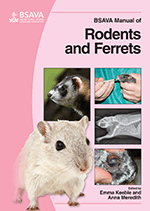
Full text loading...

The ferret is a small carnivore of the Family Mustelidae, which also contains stoats, weasels, otters and badgers. Ferrets are long thin carnivores with short legs, adapted for hunting in tunnels and cavities. Many of their features are similar to those of the dog or cat. The chapter considers where the ferret differs greatly from other species in the following areas, Skeleton; Gastrointestinal tract; Respiratory system; Urogenital system; Adrenal glands; Blood, Skin and fur; Nervous system; and Senses. In addition, the chapter discusses Reproductive biology; Behaviour; Husbandry; and Health care.
Ferrets: biology and husbandry, Page 1 of 1
< Previous page | Next page > /docserver/preview/fulltext/10.22233/9781905319565/9781905319565.17-1.gif

Full text loading...
















